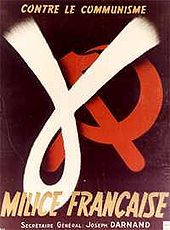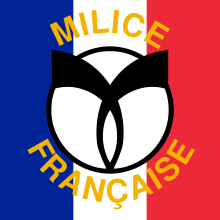- Milice
-
For other uses, see Milice (disambiguation).
 The Milice's gamma symbol.
The Milice's gamma symbol.
The Milice française (French Militia), generally called simply Milice, was a paramilitary force created on January 30, 1943 by the Vichy Regime, with German aid, to help fight the French Resistance. The Milice's formal leader was Prime Minister Pierre Laval, though its chief of operations, and actual leader, was Secretary General Joseph Darnand. It participated in summary executions and assassinations, and helped round up the Jews and résistants in France for deportation. It was the successor to Joseph Darnand's Service d'ordre légionnaire (SOL) militia.
The Milice often resorted to torture to extract information or confessions from those they rounded up. They were often considered more dangerous to the French Resistance than the Gestapo and SS since they were Frenchmen who spoke the language, had a full knowledge of the towns and land, and knew people and informers.
Milice troops, known as miliciens, wore a blue uniform coat, a brown shirt and a wide blue beret. (During active paramilitary-style operations, a pre-war French Army helmet was used.) Its newspaper was Combats. (Not to be confused with the underground Resistance newspaper, Combat.) It employed both full-timers and part-timers, as well as a youth wing. The Milice's armed forces were officially known as the Franc-Gardes.
Contents
Membership
 A recruitment poster for the Milice. The text says "Against Communism / French Militia / Secretary-General Joseph Darnand".
A recruitment poster for the Milice. The text says "Against Communism / French Militia / Secretary-General Joseph Darnand".
Early volunteers for the Milice included members of France's pre-war far right-wing parties, such as the Action Française, but also working-class men by then convinced of the blessings of Vichy's alliance with Nazi Germany.
In addition to ideology, incentives for joining the Milice included employment, regular pay and rations. (The latter became particularly important as the war went on and civilian rations dwindled steadily to almost starvation levels.) Some also joined because members of their families had been killed or injured in Allied bombing raids or had been threatened, extorted or attacked by French Resistance groups. Still others joined for less exalted reasons, such as petty criminals who were told their crimes would be overlooked if they joined the organization. Volunteers for the Milice were also exempt from being sent to Germany as forced labor.
History
The Resistance targeted individual miliciens for assassination, often in open areas such as cafés and public streets. They scored their first success on April 24, 1943, when they gunned down Marseilles milicien Paul de Gassovski. By late November, Combats reported that 25 miliciens had been killed and 27 wounded in Resistance attacks (the actual numbers were likely higher).
By far the most prominent milicien to fall to the Resistance was Philippe Henriot, the Vichy regime's Minister of Information and Propaganda, who was known as "the French Goebbels." He and his wife were killed in their apartment in the Ministry of Information in the rue Solferino in the pre-dawn hours of June 28, 1944 by résistants dressed as miliciens. The Milice retaliated for these killings by killing several well-known Anti-Nazi politicians and intellectuals, such as Victor Basch, as well as the prewar conservative leader Georges Mandel.
Confined initially to the former zone libre of France under the control of the Vichy regime (which moderated its actions and forbade some of its more radical aspirations), the radicalized Milice in January 1944 moved into what had been the zone occupée of France, including Paris. They established their headquarters in the old Communist Party headquarters at 44 rue Le Peletier as well as 61 rue Monceau, in a house formerly owned by the Menier family, makers of France's best-known chocolates. The Lycée Louis-Le-Grand was occupied as a barracks. An officer candidate school was established, likely with intentional irony, in the Auteuil synagogue.
Perhaps the largest and best-known operation by the Milice was its attempt in March 1944 to suppress the Resistance in the département of Haute-Savoie in the southeast of France near the Swiss border, the Battle of Glières.[1] The efforts of the Milice proved insufficient, however, and German troops had to be called in to complete the operation. On Bastille Day (14 July) 1944, miliciens put down with great brutality a revolt among the prisoners at Paris' notorious Santé prison.
The precise legal standing of the Milice was never formalized. It operated parallel to, but separately from, the normal (Vichy) French police force. It was outside of (indeed, above) the law such as it existed at the time and its actions were never subject to judicial review or control.
In August 1944, rightly fearing he would be called to account for the operations of the Milice, Marshal Philippe Pétain made a clumsy effort to distance himself from the organization by writing a harsh letter rebuking Darnand for the organization's "excesses". Darnand sent back a sarcastic reply, telling Pétain that he ought to have voiced his objections sooner.
The actual strength of the organization is a matter of some debate, but was likely between 25,000-35,000 (including part-time members and non-combatants) by the time of the Allied invasion of Normandy in June 1944. It began melting away rapidly thereafter, however. Following the Liberation of France, those of its members who failed to complete their escape to Germany (where they were impressed into the Charlemagne Division of the Waffen-SS) or elsewhere abroad generally faced either being imprisoned for treason, executed following summary courts-martial, or were simply shot out of hand by vengeful résistants and enraged civilians.
An unknown number of miliciens managed to escape prison or execution, either by going underground or fleeing abroad. A tiny number were prosecuted later. The most notorious of these was Paul Touvier, the former commander of the Milice in Lyon. In 1994, he was convicted of ordering the execution of seven Jews at Rillieux-la-Pape. He died in prison two years later.
In popular culture
Since the Second World War, the term milice has acquired a derogatory meaning in French.
French hard rock ensemble Trust had a hit named "Police Milice", where its frontman Bernard Bonvoisin compared modern day "cops" to the fascist lackeys of yore.
Officers of the Milice make appearances in Louis Malle's films Lacombe Lucien and Au revoir, les enfants.
The 2003 drama The Statement, directed by Norman Jewison and starring Michael Caine, was inspired by the story of Paul Touvier, a Vichy French police official, who was indicted after World War II for war crimes. The film was based on a 1996 novel by Brian Moore, with a screenplay written by Ronald Harwood. The film depicts members of the Milice participating in the arrest and execution of French Jews.
See also
- Lorenzen Group - Danish pro-German paramilitary group
- Security Battalions - Greek pro-German paramilitary group
- Maquis des Glières - resistance group that fought the Milice
- Maquis du Vercors - resistance group that fought the Milice
References
Further reading
- "Collaborationists in Arms: The uniforms and equipment of the Vichy Milice Francaise", The Armourer Militaria Magazine, issue 100, July/August 2010, pp. 24–28.
- Cohort of the Damned: Armed Collaboration in Wartime France – the Milice Francaise, 1943–45. Allotment Hut Booklets, Warwick, 2008, by Stephen Cullen.
- "Legion of the Damned: The Milice Francaise, 1943-45", Military Illustrated magazine, March, 2008, by Stephen Cullen.
- Paris in the Third Reich: A History of the German Occupation, by David Pryce-Jones. London: Collins 1981.
- "Resistance in France", After the Battle magazine, No. 105, 1999.
Categories:- Far-right politics in France
- National security institutions
- Political repression
- Defunct law enforcement agencies of France
- Military of Vichy France
- French Nazi collaborators
- Militias in Europe
- 1943 establishments
- 1944 disestablishments
Wikimedia Foundation. 2010.




